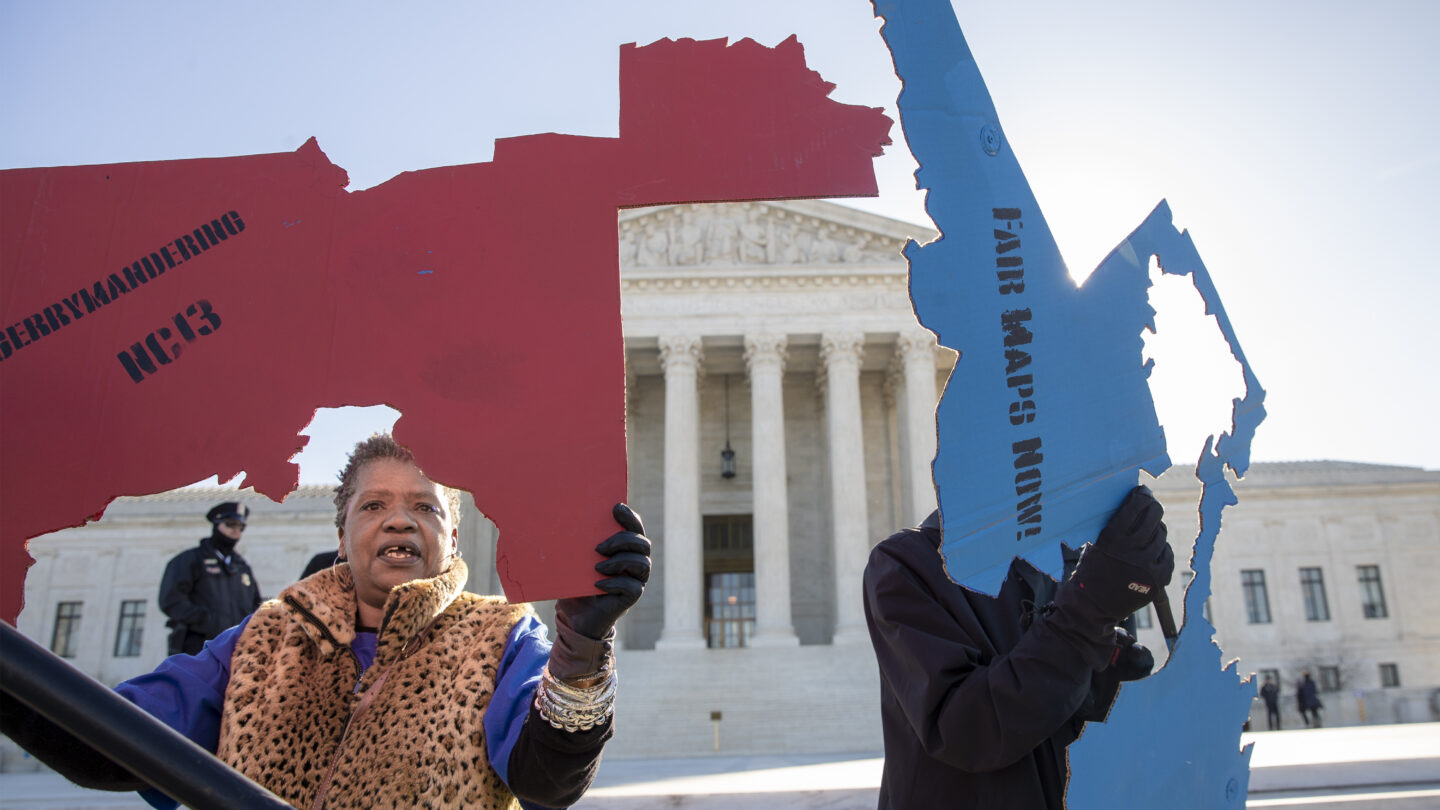Is drawing a voting map that helps a political party illegal? Only in some states

A recent unusual ruling by North Carolina’s highest court has put a spotlight on the patchwork of state laws and court decisions that determine where maps of voting districts can be drawn to make elections less competitive and certain political parties more likely to win.
The practice is known as partisan gerrymandering, which, courts have found, both Republicans and Democrats have deployed when in control of redistricting.
In 2019, the U.S. Supreme Court’s conservative majority ruled that partisan gerrymandering cases are “beyond the reach of the federal courts,” punting the issue to state courts. And national reform efforts have failed so far. In the last Congress, a Senate Republican filibuster repeatedly blocked Democratic-led voting rights legislation that would have included a ban on partisan gerrymandering.
That’s left a state-by-state fight over the extent to which partisan politics can drive the redrawing of voting maps after the 2020 census. In some states, independent redistricting commissions have made the process less partisan by taking it out of the hands of politicians. But in others, mapmaking by partisan lawmakers has ultimately involved legal battles over claims of partisan gerrymandering.
“In some states, you can get away with it. In some states, you can’t,” says Michael Li, senior counsel at the Brennan Center for Justice at New York University School of Law, which advocated for partisan gerrymandering bans that were part of voting rights bills in Congress. “While you might be able to partisan gerrymander to your heart’s content in Texas, you can’t in New York. And that’s a very uneven playing field.”
How the lines of voting districts in your state can be drawn depends in large part on who’s sitting on your state’s courts, what your state’s constitution says, and how the courts interpret and enforce those words.
Which states’ constitutions have language that bans partisan gerrymandering?
While some states have statutes against partisan gerrymandering, more than a half-dozen states have constitutions with some type of explicit language against favoring a political party when redrawing voting districts, including California, Colorado, Florida, Hawaii, Michigan, New York, Ohio and Washington, according to the National Conference of State Legislatures.
Short of explicit bans, there are also states with other types of constitutional language that could protect voters from partisan gerrymandering, says Jonathan Cervas, a redistricting expert and postdoctoral fellow at Carnegie Mellon University’s Institute for Politics and Strategy, who recently redrew New York’s congressional maps as an appointed special master after courts threw out maps that were gerrymandered by Democrats.
“This might be considered what I would call indirect language, where there are protections in the state constitutions that are unrelated to partisan gerrymandering per se, but are directly related to voting rights,” explains Cervas, who has written about the role of state courts in limiting partisan gerrymandering.
That kind of state constitutional language often requires elections to be “free,” “free and equal” or “free and open,” and it is part of the founding documents of more than two dozen states, according to the NCSL.
But whether any constitutional language has been used to stop partisan gerrymandering “depends on whether the state court where you live is willing to protect your rights,” Cervas adds.
Where have state courts thrown out voting maps because they were found to be favoring one party?
In recent years, states where courts have rejected voting maps in partisan gerrymander cases include Alaska, Maryland, New York, Ohio and Pennsylvania. There are also open cases before the state supreme courts of New Mexico and Utah.
State courts have become the battleground for partisan gerrymandering after the U.S. Supreme Court’s landmark 2019 ruling in the case known as Rucho v. Common Cause.
“For several decades, people in the states had held out hope that the Supreme Court would lay down a standard for finding that partisan gerrymandering had happened and potentially overruling maps where that kind of vote rigging had happened,” says Kathay Feng, vice president of programs at Common Cause, the advocacy group that has also helped lead the ongoing case against a North Carolina congressional map approved by Republican state lawmakers.
But the country’s highest court decided that federal courts cannot review claims of partisan gerrymandering because, in the words of the conservative majority’s opinion by Chief Justice John Roberts, the U.S. Constitution does not have a “Fair Districts Amendment.”
“Provisions in state statutes and state constitutions can provide standards and guidance for state courts to apply,” Roberts added.
“After the Rucho decision, people asked me whether I was depressed or not, and I said, ‘No, disappointed but not depressed,’ because there was a lot going on in the states,” says Li, the Brennan Center attorney, adding that states are “laboratories of democracy” where there have been efforts to create more independent redistricting commissions and state constitutional bans on partisan gerrymandering.
Still, Li notes that states can also be “laboratories of not protecting democracy.”
“Ultimately, there has to be some kind of federal remedy, because the reality is that while state courts may be able to do a lot, state courts aren’t going to be willing to intervene everywhere,” Li says. “Texas and Florida are prime examples of places where state courts are unlikely to police really aggressively drawn maps.”
Why was the North Carolina Supreme Court’s recent ruling so unusual?
After a judicial election, states where courts are likely to intervene in partisan gerrymandering can, however, flip to the other end of the spectrum.
Take North Carolina, for example. In 2022, the state’s highest court, under a Democratic majority, struck down a congressional map approved by Republican state lawmakers as a partisan gerrymander that violated multiple provisions in North Carolina’s constitution, including “All elections shall be free.”
But after Republican justices took over the North Carolina Supreme Court’s majority following last year’s midterm elections, the court made the unusual move to rehear the case this year at the GOP lawmakers’ request. The justices ultimately reversed the court’s earlier ruling.
In the majority opinion, North Carolina Supreme Court Chief Justice Paul Newby, a Republican, wrote that “creating partisan redistricting standards is rife with policy decisions,” which “belong to the legislative branch, not the judiciary.”
North Carolina’s U.S. House delegation is currently split, with seven Democrats and seven Republicans. Under the new ruling, GOP state lawmakers could redraw the congressional map to favor Republicans in a closely divided state.
And for many redistricting watchers, the reversal at the North Carolina court is another stark reminder that elections for state judges matter.
“I think everybody is aware of the fact that the facts didn’t change. And the only thing that did change was an election, which changed who was in control of the court,” says Theodore Shaw, a law professor and director of the University of North Carolina Center for Civil Rights. “Courts do not hold themselves out to be political, but politics count for the change in this court and undoing what it decided a fairly short time ago.”
How could the U.S. Supreme Court make it harder to limit partisan gerrymandering again?
This redistricting case out of North Carolina, which has been appealed to the U.S. Supreme Court as Moore v. Harper, also comes with national implications that could undo any state court’s ability to review congressional maps approved by state lawmakers.
North Carolina GOP state lawmakers are calling for the country’s highest court to endorse a once-fringe idea that the U.S. Constitution gives state legislatures a special power to control how congressional elections are run that cannot be checked or balanced by state constitutions or state courts.
Known as the “independent state legislature theory,” the claim could put an end to one of the main remedies to partisan gerrymandering in legislature-approved congressional maps that the U.S. Supreme Court had suggested in its ruling in Rucho — suing in state courts.
Cervas, the redistricting expert at Carnegie Mellon, is concerned that the U.S. Supreme Court’s support for some version of the theory could leave voters with no way to “protect themselves from governments that are going to create redistricting plans that are poised to diminish the votes of one political party.”
The North Carolina Supreme Court’s decision to rehear the state-level case and overturn its ruling has raised the possibility that the country’s high court may soon dismiss the case.
But a similar case about the theory, brought by Republican state lawmakers in Ohio, sits in the wings, waiting for a decision by the justices on whether to hear it.
Edited by Benjamin Swasey
9(MDAxODM0MDY4MDEyMTY4NDA3MzI3YjkzMw004))








